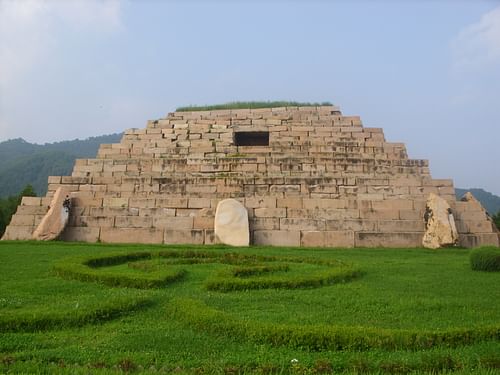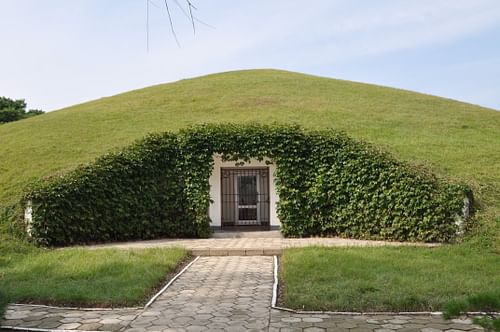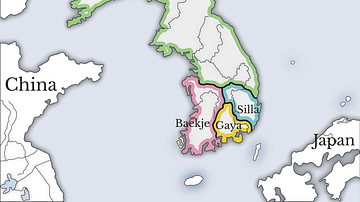Goguryeo (Koguryo) ruled northern Korea during the Three Kingdoms period from the 1st century BCE to 7th century CE, and the best evidence of the kingdom's prosperity and artistry can be found in the many surviving tombs of the period. The murals inside many of the tombs are an invaluable insight into the ceremonies, warfare, architecture, and daily life of ancient Korea. The tombs are designated a World Heritage Site by UNESCO.
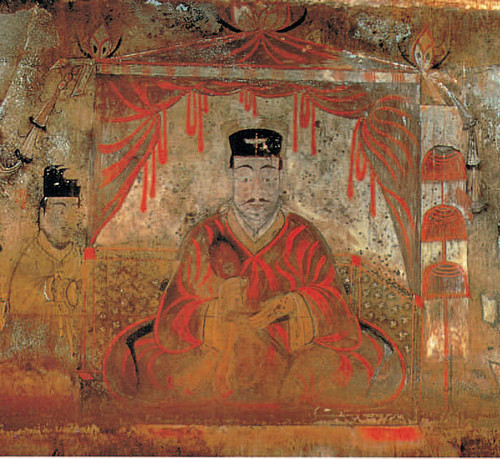
Architecture
There are over 10,000 Goguryeo tombs of one sort or another, with the earliest ones taking the form of stone cairns using river cobbles. By the 4th century CE, square tombs were constructed and placed within pyramids made of cut-stone blocks. Later tombs were built in the form of huge earth mounds which most often have a rectangular base. The earth was mixed with lime and small pebbles to make it firmer and so better keep its outward shape. Additional layers of stones and clay mixed with lime and charcoal were placed immediately over the inner stone chamber and under the earth mound to make the tomb waterproof. These precautions have helped protect the murals inside many tombs. The border of the mound could be marked out using river cobbles but many of these markers have long-since disappeared.
Inside the mound are stone slab or brick-lined chambers accessed by a horizontal passageway. The thick stone slabs are cut for the purpose and may be either granite or limestone. Again, some inner chambers were lined with lime mortar and have drainage channels to protect them from the elements and to minimise water damage over the centuries. The floors of chambers are cemented with a mix of soil, lime, charcoal, pebbles, and sand with the whole covered in lime mortar.
Some mounds have a single chamber while others have additional rooms off the main burial chamber which are separated from each other by stone columns. The entrance passage can lead either directly to the main tomb chamber or to a side chamber. The coffin or coffins were placed on stone bars to keep them off the ground and, later, on a lime-plastered table. Sometimes there is a stone table set into the wall for religious objects and a small traditional fireplace, presumably for use in the burial service. The main chamber was closed off using a single or double stone door. Many Goguryeo tomb chambers include corbelled roofing of various designs, octagonal pillars supporting stone cross-beams, niched walls, and even pivoted stone doors. In general design the tombs display the close cultural ties between the kingdom and ancient China.
Although most tombs are more modest hemispherical earth mounds built over a square base and with a single interior tomb chamber of stone, some tombs are spectacularly grandiose. The largest tomb is at the former capital Gungnae (modern Tonggou) and thought to be that of King Gwanggaeto the Great (r. 391–412 CE), hence its popular name 'the General's Tomb.' 75 metres long, 11 metres high, and using 1,100 blocks measuring 3 x 5 metres, the tomb also has four smaller dolmen-like structures at each corner. Another important tomb is that of Tong Shou, last ruler of Taebang. Located near Pyongyang, an inscription dates the tomb to 357 CE. Its central chamber has 18 limestone columns and wall paintings; it is surrounded by four smaller chambers.
Wall Paintings
An important Goguryeo artform was wall painting. Around 80 Goguryeo tombs contain murals, either painted directly onto the stone chamber walls or applied to a lime plaster. Bright colours and flowing outlines are a typical feature of Goguryeo paintings. Perhaps the most famous surviving examples are found in the 5th-century CE Muyonchong or 'Tomb of the Dancers' at Gungnae. One mural, which gives its name to the tomb, has rows of servants dancing with arms raised as they bid farewell to their master who is leaving the family home on horseback, presumably a metaphor for his departure into the next life. The dancers wear either long-sleeved robes or jackets and trousers tied at the ankles.
In several tombs there are paintings of the actual occupant, and one of the best preserved is from a side chamber of Tomb No. 3 at Anak, 357 CE. The man is identified by an inscription in the tomb as Tong Shou, the last ruler of the Chinese commandery of Taebang. He is depicted receiving officials while sitting on a jwasang chair. The figure wears a double-hat and sleeved robe, and is holding a feather fan. The various officials at the audience are painted in different sizes to represent their different ranks.
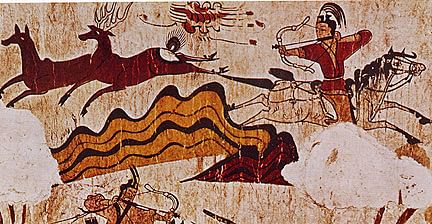
Hunting scenes are a very popular choice of painted scene, and one of the most celebrated is from the wall of the burial chamber within the Muyongchong tomb. The dynamic scene is composed of two distinct areas separated by a grove of trees. On the right side are two ox-drawn carriages while on the left hunters on horseback fire arrows at fleeing deer and a tiger which leap between trees and mountains.
Other chambers have paintings of warriors on horseback, mythical animals, animal tamers, acrobats, religious ceremonies, political processions, and a myriad of details of daily life and architecture. As with their architectural design, the murals of Goguryeo tombs display more Chinese influence with constellations painted on many of the ceilings, roof corbels painted with the lotus flowers so common to Buddhist art, and, above all, images of the Chinese animals of the four directions on the walls.

Constellation scenes usually include a sun and moon, which indicate east and west respectively. The sun is typically represented by a three-legged crow with a peacock crest inside a wheel while the moon can take three different forms: a pair of toads, rabbits, or cinnamon trees, again inside a wheel. These were important symbols of the state and may represent a link with shamanism and the importance of nature in early Korean culture. The most common constellations depicted are Sagittarius and the Great Bear and, besides a link with Taoism (where they represent life and death respectively), indicate the close relation Koreans assumed between the stars and human affairs.
The animals of the four directions are common to a great many tombs, and they are the Blue Dragon (east), White Tiger (west), Red Phoenix (south), and Black Tortoise-Snake (north). One creature was painted on each wall of the main tomb chamber, which is in contrast to Chinese tombs where they only appear on ceilings, and they collectively acted as guardians. It is likely that just as Korean painters learned from their Chinese counterparts, so too, they passed on their knowledge to artists in Japan as many tombs there are similar in their artistic decoration.
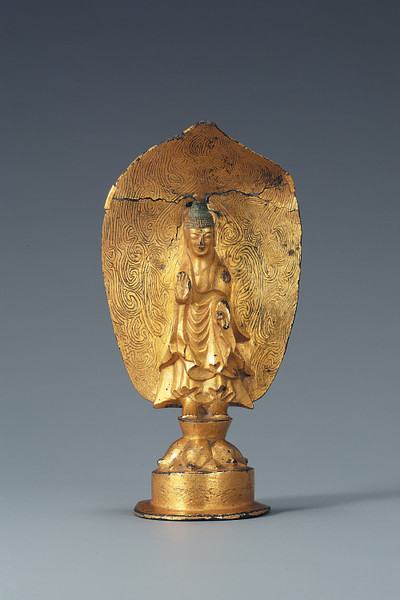
Artefacts
Tombs are also a source of artefacts but the tendency to build easily accessible horizontal entrances has meant that many Goguryeo tombs were looted long ago. Some few surviving art pieces include two gilt-bronze crowns and jewellery (rings, earrings, bracelets, and hairpins) which are testimony to the craftsmanship of their creators. Very few examples of Goguryeo pottery have survived and are of dubious provenance. More numerous are bronze and gilt-bronze figurines of the Buddha which typically show Northern Wei influence with a flaming mandorla and flanked by seated bodhisattvas.
This content was made possible with generous support from the British Korean Society.
